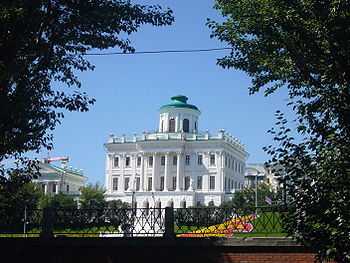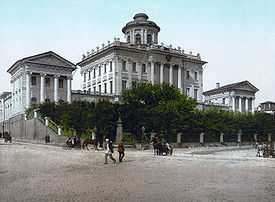Pashkov House

The Pashkov House is the famous Neoclassical mansion that stands on a hill overlooking the western wall of the Moscow Kremlin, near the crossing of the Mokhovaya and Vozdvizhenka streets. Its design has been attributed to Vasily Bazhenov. It used to be home to the Rumyantsev Museum (Moscow's first public museum) in the 19th century. The palace's current owner is the Russian State Library.
Construction
The Pashkov House was erected in 1784—1786 by a Muscovite nobleman, Pyotr Pashkov. He was a retired Captain Lieutenant of the Guards Semenovsky Regiment and the son of Peter the Great's batman.[1] The building is believed to have been designed by Vasili Bazhenov. Throughout the 20th century Bazhenov's authorship was disputed, since no written evidence has survived the ages, and the only thing that serves as a proof is oral tradition and similarities to Bazhenov's other buildings.
Renown

As soon as it was completed, the Pashkov House became a landmark of Moscow. For many years a splendid palace of white stone standing on the Vagankovsky Hill has amazed people and is considered to be one of the most beautiful buildings in the Russian capital. It is one of the key locations described by Mikhail Bulgakov in his novel The Master and Margarita:
"At sunset, high over the city, on the stone terrace of one of the most beautiful houses in Moscow, a house built about a hundred and fifty years ago, there were two: Woland and Azazello. They could not be seen from the street below, because they were hidden from unwanted eyes by a balustrade with plaster vases and plaster flowers. But they could see the city almost to its very edges."[2]
Owners

- The initial owner of the Pashkov house was Pyotr Pashkov, after whom it was named by the Muscovites.
- Upon the death of Pyotr Pashkov and his spouse, the estate passed on to his cousin Aleksandr Pashkov.
- The Pashkov house was purchased by the government for Moscow University in 1839. An Institute for the Nobility (a male boarding school for children of the nobility) was located here in 1843; and later the 4th city grammar school (after 1852).
- The building was transferred to the Rumyantsev Museum to house its collections and library, in 1861.
- In 1921, since more than 400 private libraries were confiscated by the Soviets and added to the Museum, all departments were moved out of the Pashkov House. Only the Museum's library remained there, which was renamed and reorganized into the Lenin Library. At present (2010), the Pashkov House is still among the Library's buildings, but for several decades it was out of use, being under permanent repair, which started in 1988 and ended in 2007. Nowadays, the right wing of the Pashkov House houses the Manuscripts Department, while its left wing houses the Music Department and the Maps Department, of the Russian State Library.
Description
Location
Impressive view of the building is partly due to the site where it was built. The Pashkov House stands on a high Vagankovo hill, as though continuing the line of its ascent, on an open corner of two descending streets. The front facade faces the sunny side. The mansion was erected a bit skewed and not along the straight line of the street relative to the street and to the entrance from the Starovagankovsky Lane. Because of this, the Pashkov House is better perceived from sideways, farther angle viewpoints.
Location of the building also has a symbolical importance: the Pashkov House towers a hill opposite the Borovitsky hill topped by the Kremlin. It was the first secular building in Moscow, from the windows of which one could see the towers and building of the Kremlin not bottom upwards, and could observe Ivanovskaya Square and Cathedral Square.
Estate lay-out
The building has a varied and interesting silhouette, being formed by three compact cubages: main building and two flanking service wings. The mansion, being at the same time a town manor, has a flat-topped lay-out with a court of honor opened towards the entrance. The solution is unorthodox, since the entrance is from the side street and not from the main facade, and the traditional lay-out is inverted. the high hill serves as a base of the building. There was a garden in front of the mansion before 1930s.
Lay-out of the garden in front of the building impresses by its splendor:
"There are two stone reservoirs with fountains in the center. A grille of marvelous design separates the house from the street. The garden, same as the pond, swarms with exotic uncommon birds. Chinese geese, parrots of various species, white and piebald peacocks are here at large or hang in expensive birdcages. These rarities coupled with the general beauty of this house attract here on Sundays and public holidays numerous crowds."
- (Richter, Johann G., Moskwa. Eine Skizze. Leipzig: Hartknoch, 1799.)
When the Mokhovaya Street was expanded, the land plot adjacent to the house, shrunk to the slope only.

The only entrance to the Pashkov House accessible for coaches was from the Starovagankovsky Lane. It is on the same axis with the main cubage of the building, which is underlined by the whole system of development of the palace. A principle of contract is extensively applied: large and small are contrasted:
- the central cubage of the building vs. service premises and fences;
- the expanded court of honor preceding the main entrance vs. narrow trapezoidal funnel connecting the entrance and the court of honor;
- the funnel mouth corresponds to the projection on the facade of the main building; and
- rectilinear contours of the court and of the funnel are connected by curvilinear walls.
Such general layout involving contrasts is influenced by the preceding Baroque period with its love of intricately interpreted volume. A three-dimensional system is formed, which is full of contrast effects and contributing to more dramatical perception of the architectural dominant of the whole complex, the main building.
Adjoining to the estate is Saint Nicholas Church, which used to be a family chapel.
Neoclassical facades
The Pashkov House has two main facades, one facing the carriageway and being palatial and solemn, the other facing the yard and looking cozier and more like a country estate.
The facade looking on to the Mokhovaya Street is characterized by linear expansion. The arrangement centrifugally unwraps around and above. Two one-storey tunnels run to the right and to the left of the central cube ending in two-storied Service wings. The main building has colonnaded porticos on both sides. The building is topped with a cylindrical belvedere. These devices are common for Palladianism.

Order system
In contrast to rusticated ground floor, the porticoes use great order linking two floors. Thanks to a not-too-high but full-width base, such linking of the two floors by a colonnade increases immensity of the building.
Three porticoes of the facade are located head-on. The Pashkov House is a rare sample in the global architecture, where three porticoes are used for such facade arrangement, which are absolutely similar by their main dimensions and number of columns. Only the order used is different.
The columns and pilasters of the central building use composite Corinthian order (it is pictured in its details with more freedom and distinction as compared to usual canons). There are statues put on column bases, on each side of the four column portico.
The columns and pilasters of the service wings use intricate Ionic order with the so-called diagonal column caps emphasizing artistic independence and role of the service wings in the facade arrangement.
The balustrade enframing the roof of the central building has magnificent vases on the posts which smooth passage from frieze and cornice to the belvedere topping off the central cubage. The belvedere is not such static form as a pediment, and emphasizes the ascent of the whole arrangement, augmenting the Pashkov House building.
Inner layout
Main and most grand premises of the palace were in its central building, entrance to which was along the axis of the building, from the side of the соurt of honor. Main vestibule was also located along the axis of the main building, where you can see the grand staircase. To the right of the vestibule, clear of the central axis, there was a grand staircase to the first floor leading to the ante-room and to the main hall. The service wings accommodated residential and service rooms.[3]
Building conversions
According to some sources, original color of the walls was orange. Paul I started changing the Bazhenov's appearance of the building: upon his orders, the statue of Minerva (or Mars, symbolizing the victories of the reign of his mother) crowning the dome, was removed from it.
Imperial period
During the Napoleon's invasion the building suffered heavy damage: the wooden belvedere with the Corinthian order roundabout colonnade crowning the building was destroyed, as well as a large statuary and coat of arms of the Pashkovs on the entablature of the central portico.[4]
Revolution and Soviet period
Interesting facts
- The depths of the Vagankovsky hill under the Pashkov House are deemed to be one of several possible locations of the legendary library of Ivan the Terrible.
- The Pashkov House is described in Bulgakov's novel The Master and Margarita as the meeting place of Woland, Azazello and Levi Matvei.
Other Pashkov houses
- "Pashkov Dom" (Pashkov House) is the name of the publishing house of the Russian National Library.
- "Pashkov House' (Russian: «Пашков дом») is the name of a novel by Nikolai Shmelyov (Николай Шмелёв).
- Pashkov House (Second Pashkov House, Lecture Building (Russian: Аудиторный корпус), Pharmacy House (Russian: Аптекарский дом)) — these are the names under which the building of the Journalism Department of the Moscow University is mentioned in old documents. The building is also located on the Mokhovaya Street, 9. The reason was because the estate was also owned by a Pashkov, Alexander Illich Pashkov, a relative of Pyotr Pashkov. Another house owned by the Pashkovs was at Chistoprudny Boulevard, 12 .[5]
- Pashkov's villa in Saint Petersburg, at 39 Liteyny Prospekt (architect Harald von Bosse), praised by Nikolay Nekrasov in one of his poems.
See also
References
- ↑ The return of Pashkov House
- ↑ Mikhail Bulgakov, The Master and Margarita, ch. 29.
- ↑ Brunov N. I. Istoriya russkoy arkhitektury. Moscow, 1956. P. 200. (Russian)
- ↑ Arkhitekturniye ansambli Moskvy XV — nachala XX vekov /Ed. by T. F. Savarenskaya/. — Moscow, 1997. P. 227. (Architectural Complexes of Moscow of 15th to early 20th Century) (Russian)
- ↑ «Привычки милой старины» или Пушкин на масленице 1831 года
External references
| Wikimedia Commons has media related to Pashkov house. |
Coordinates: 55°44′59″N 37°36′30″E / 55.74972°N 37.60833°E